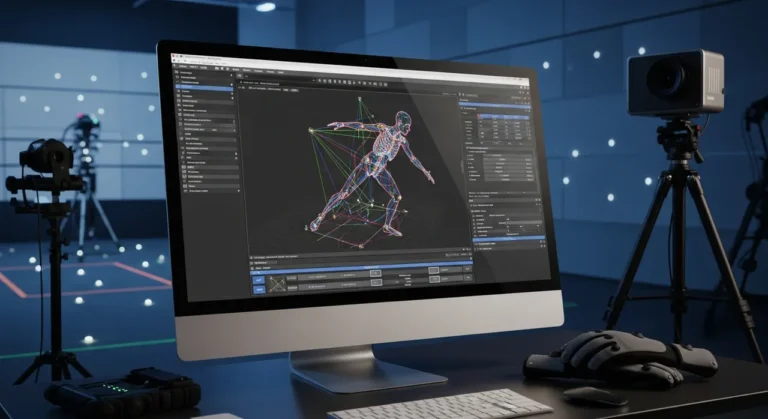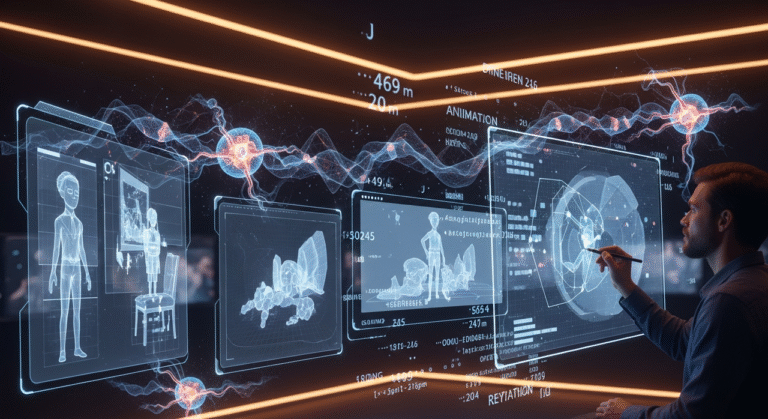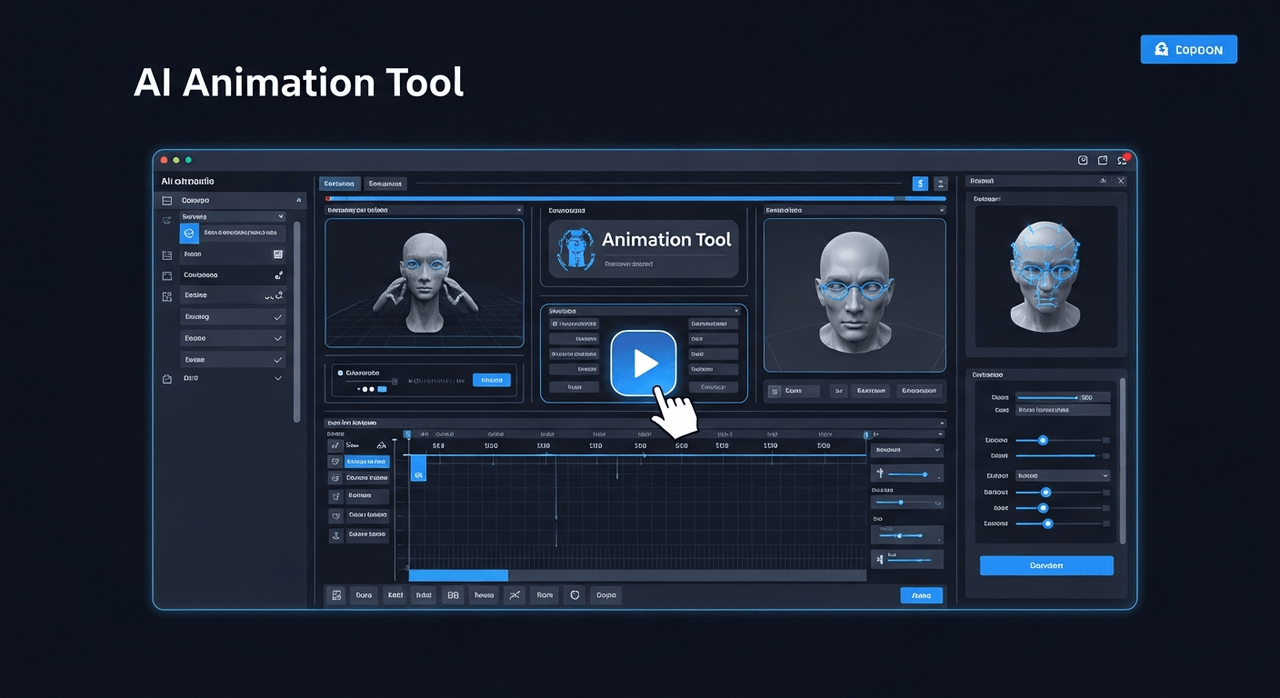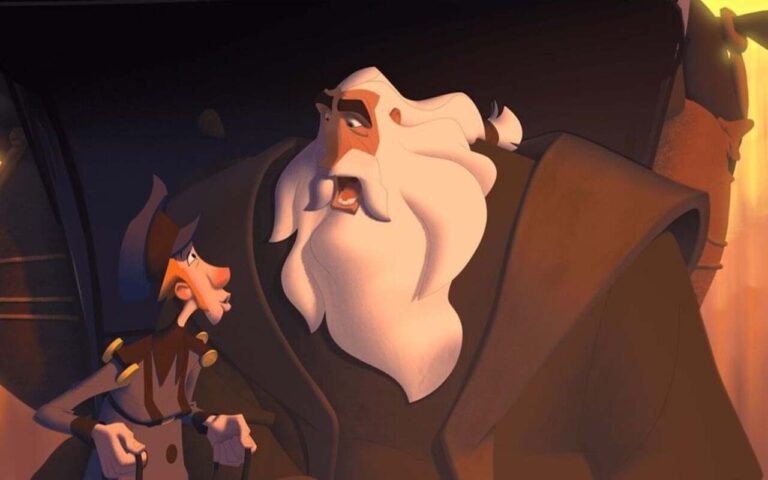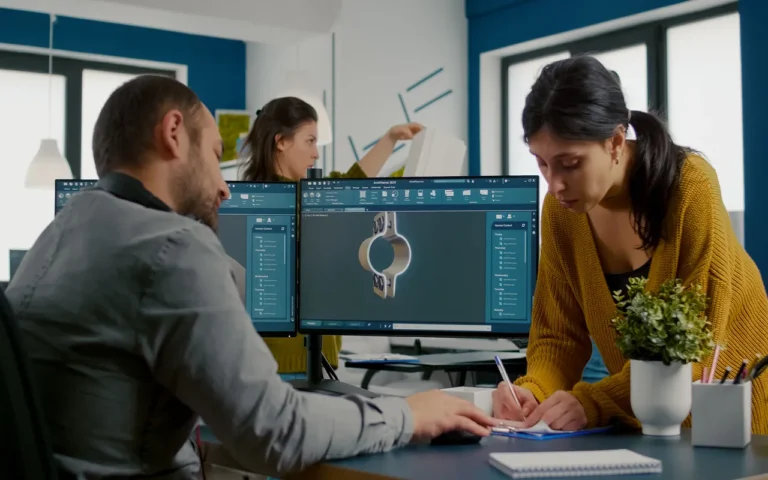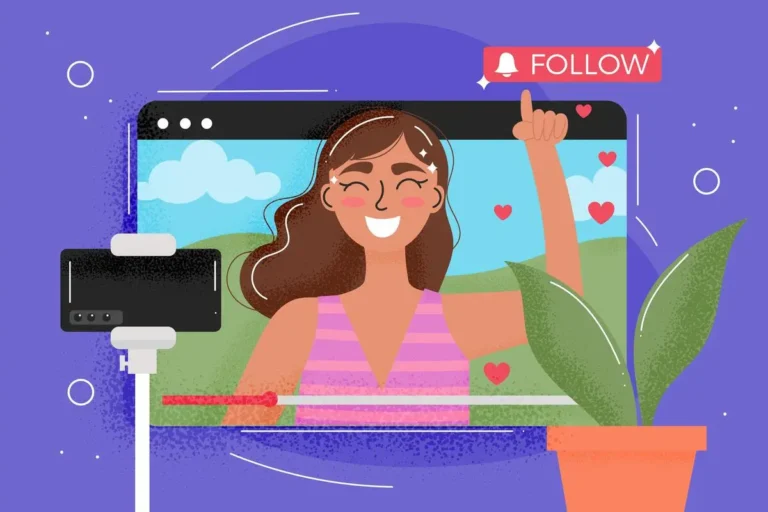By definition, 3D animation means creating visuals in a three-dimensional digital environment, in contrast to 2D animation with its flat appearance.
3D animation has become an integral part of all kinds of businesses, from entertainment and advertising to education and virtual reality.
Whether you’re a student, an animator, a professional in the field, or a business owner looking to investigate, understanding the fundamentals of 3D animation is crucial due to the ever-growing uses of 3D animation.
But what exactly is 3D animation, and how is it created? Stay with us to explore 3D animation and discuss its core values.

Need 3D Animation Services?
Visit our 3D Animation Service page to see how we can help bring your ideas to life!
What Is 3D Animation?
3D animation involves creating moving images in a three-dimensional and lifelike digital environment.
Unlike 2D animation, which exists on a flat plane, 3D animation allows for depth and volume, making it possible to create lifelike characters and realistic environments.
The process of creating 3D animation is intricate, involving multiple stages, each requiring specialized skills and tools to bring the vision to life.
For instance, Pixune, as a major 3D animation studio, has managed to combine creative vision with precise animating techniques to bring to life the most meticulous visual arts.
Without further ado, let’s delve into exploring the main stages of 3D animation creation and its concepts in the following section!
The History of 3D Animation!
The emergence of 3D animation mirrors the growth of a child, starting with its early conception in the 1960s. Innovators, including Ivan Sutherland, paved the way with pioneering computer graphics experimentations to give birth to the idea of 3D animation.
The 1970s marked 3D animation’s developmental stages with the computational enhancement of image depth and the release of a short film titled “Futureworld”, showcasing the first computer-generated hand and face, hinting at the vast potential that lay ahead.
3D animation began to take a more defined form in the 1980s and 1990s. The release of “The Adventures of Andre and wallyB” a product of Lucasfilm Computer Graphics Projects which later evolved into what we know as Pixar, demonstrated the abilities of 3D animation to create dynamic and engaging characters.
Toy Story, the first fully computer-animated full-length film was a watershed moment in the industry, proving that 3D animation is equipped with the means to tell compelling stories that captivate audiences all around the world.
Today, 3D animation has reached the stage of maturity, becoming a corestone of visual media across various industries including film, video games, virtual reality, and advertising.
The 3D Animation Pipeline (Step-by-Step)
There are many variables in the creation of a well-made 3D animation.
In the following, we will briefly review the 3D animation pipeline and its key stages.
1. Pre-Production:
Top 3D animation studios starts with concept development and storyboarding, where the creative vision is first formulated and structured.
- Concept Development: In this phase, animators brainstorm and refine the core ideas for the animation, defining the story, characters, and visual style. The concept art stage is crucial as it sets the project’s overall direction and tone, ensuring that every subsequent step aligns with the original vision.
Once the concept is clear, the next step is storyboarding. - Storyboarding is the process of translating ideas into a visual sequence. It is essentially a series of sketches or digital frames that represent key scenes, actions, and camera angles. Storyboards serve as a visual guide, laying out the timing, pacing, and narrative flow. Storyboarding is indispensable in ensuring that the animation progresses smoothly, maintaining coherence between the initial concept and the final product.
2. Production:
The production stage is where the magic of 3D animation truly comes alive!
3D animation production includes 3D modeling, texturing, rigging, animating, lighting, and camera work. It’s a highly collaborative and technical phase where all the pre-production planning must be meticulously executed.
1) 3D Modeling:
First in the production phase is 3D modeling, which involves creating a digital representation of anything to be shown in the animation, including objects, characters, or environmental illustrations.
Constructing the layout in 3D animation and its role in production makes out the importance of 3D modeling stage.
In this stage, artists use computer software to carve shapes and structures.
3D models are the foundation of the animation, serving as the scaffold upon which all other elements are assembled.
2) Texturing:
The 3D texturing process typically begins after the 3D model has been created. It is a critical step in the 3D animation pipeline that smoothly breathes life into digital models by adding color, patterns, and surface details.
3D models would appear flat and unrealistic without textures, lacking the distinctive details that make objects look authentic and tangible.
Texturing involves applying a 2D image, known as a texture map, onto the surface of a 3D model. This texture map acts like a coating, wrapping around the model and giving it visual characteristics such as color, patterns, and material properties.
High-end texture quality is fundamentally important, as it can make a radical difference between a model that looks like a plastic toy and one that convincingly imitates real-world materials.
Moreover, well-done texturing can deliver essential narrative information, such as whether a character is tired, wounded, or clean, and set the tone of a scene.
The texturing aspect is critical to making the animation more believable for the audience.
3) Rigging:
Rigging is the process of adding an internal structure, or “skeleton,” to a 3D model, which enables it to move, function, and interact with its environment.
This skeleton comprises bones and joints that direct how the model will bend, stretch, and rotate, much like in an actual living organism.
The rigging process is essential in giving life to static models by allowing them to perform a wide range of movements, from simple motions like walking and talking to complex actions like acrobatics or facial expressions.
Creating a rig requires a deep understanding of artistic principles and movement mechanics.
The rigging artist must delicately design the skeleton to make sure that the character or object moves naturally and convincingly.
The rigging process involves carefully placing bones and joints in strategic locations corresponding to the model’s anatomy, allowing for realistic changes and deformations during movement.
For example, consider a scene where a boat is crossing a lake. Rigging would involve creating a system that allows the lake’s surface to react dynamically to the impact of the boat.
4) Animating:
Once the rigging process is complete, the animating phase begins, where the rigged models come to life.
Animators manipulate the models using the rigged skeletons, creating sequences of movement that bring action, emotion, and interaction to the animation.
During this stage, animators focus on timing and fluidity to ensure that the movement appears natural and believable.
For instance, when animating a character walking, animators carefully adjust the timing of each step, body movements, and the shift of weight from one foot to the other, ensuring that the movement feels as realistic as possible.
Moreover, they might add secondary motions, such as a character’s clothing or hair following their movement, to enhance the overall believability of the scene.
For this stage of production, We primarily exploit two widely known animation techniques:
- Keyframe Animation:
Keyframe animation is a technique in which animators manually set specific frames, known as keyframes, at central moments in a sequence. The software then automatically generates the in-between frames, known as “tweens,” to create smooth transitions.
This method offers animators complete control over the movement and timing, allowing them to produce nuanced and striking animations. - Motion Capture (MoCap):
Motion Capture (MoCap) is another technique widely used in film and video games.
MoCap involves recording real-life movements using sensors attached to a performer’s body. These movements are then mapped onto the digital model, resulting in highly realistic animation that mirrors the actor’s performance.
Mo-cap is particularly useful for capturing complex, lifelike motions that would be time-consuming and challenging to animate by hand, such as the fluid dynamics of a character swimming through water or the subtle shifts in weight during a walk.
5) Lighting and Camera:
In 3D animation, lighting and camera angles are critical for shaping the visual narrative and enhancing the emotional impact of a scene.
- Lighting establishes mood, highlights desired elements and adds depth to the environment. By manipulating light sources, animators can simulate different times of day or draw focus to the textures and shapes of 3D models, making them more lifelike.
- Camera angles guide the viewer’s perspective, influencing how the audience perceives the action and emotions within the scene. Strategic camera placement, distance, and movement allow animators to emphasize power, intimacy, or tension, ultimately crafting a visually dazzling and immersive story that connects with the audience.
6) Rendering:
The final step in the 3D animation process, rendering, is where a scene’s elements come together to create the final image or sequence of images that the audience will perceive. During rendering, powerful computer software processes the 3D models, textures, animations, lighting, and camera angles to generate the final images.
This stage is incredibly complex, as it involves simulating the behavior of light, shadow, and reflections and calculating how materials interact with light sources based on their properties.
3. Post-Production:
Post-production is another crucial stage in the 3D animation process that involves refining the raw animation into a polished final product.
- Editing: This stage begins with editing, where animators and editors cut and arrange the animated scenes to ensure a smooth narrative flow. The pacing, timing, and overall structure of the animation are fine-tuned to enhance the storytelling.
- Soundtrack: In addition to sequencing the scenes, post-production also includes adding sound effects and music. Sound plays a significant role in developing a lively animation, as it can dramatically influence the mood and emotional impact of a scene. From the subtle sound of footsteps to the crescendo of a dramatic scene, every audio element is discreetly synchronized with the visuals to create a cohesive and joyous experience.
- Visual Effects (VFX): Another key aspect of post-production is incorporating visual effects (VFX). This step involves adding elements that were not originally part of the 3D animation, such as explosions or weather effects like rain.
VFX artists use specialized software to create these effects, ensuring they blend seamlessly with the existing animation.
The process can also involve color grading, where the animation’s color palette is adjusted to maintain visual consistency and trigger specific emotions.
Together, these enhancements help to elevate the animation, adding depth, realism, and visual interest.
The culmination of all these efforts in post-production is what turns a simple animation into a fully immersive, engaging experience for the audience.
The Digital Toolbox: Software for 3D Animation
In 3D animation production, a wide array of software applications play a critical role in bringing creative visions to life. These tools are designed to handle different aspects of the animation process, from modeling and rigging to texturing, lighting, and rendering.
Here’s a brief introduction of some of the most commonly used software in 3D animation production:
- Autodesk Maya: Autodesk Maya is a top-tier 3D animation software known for its powerful modeling, simulation, and rendering tools. Popular in film, TV, and gaming, it’s a preferred choice for animators.
- Blender: Blender is a popular open-source 3D creation suite renowned for its extensive tools and free access. It’s widely used by both hobbyists and professionals for crafting everything from detailed character models to full-length animated films and video games.
- Autodesk 3ds Max: Autodesk 3ds Max is a powerful 3D modeling, animation, and rendering software widely used in architecture, game development, and visual effects. Its extensive features, including advanced modeling tools and an intuitive interface, make it a top choice for creating detailed environments, characters, and complex animations.
- Houdini: Houdini is a premium 3D animation software acclaimed for its advanced procedural generation capabilities. Favored by visual effects artists, it excels at creating complex simulations like fire, smoke, and fluid dynamics. Houdini is widely used in blockbuster films, video games, and commercials for its exceptional control over intricate animations.
- ZBrush: ZBrush is a digital sculpting software renowned for creating highly detailed models with intricate textures. Popular in film, gaming, and 3D printing, it is admired for its user-friendly design and powerful sculpting tools, empowering artists to achieve greater levels of creativity and realism.
Where Is 3D Animation Used?
Today, 3D animation has become a cornerstone of visual media across various industries, including film, video games, virtual reality, and advertising.
With a solid understanding of 3D animation fundamentals, we can explore its diverse applications. Each type of the following applications employs specific techniques and fulfills unique roles across various contexts, from interactive games to film productions.
Below, you’ll find an overview of some key areas where 3D animation is utilized:
- Interactive 3D: True to its name, interactive 3D animation involves creating animations that respond to user input, allowing for dynamic engagement within the fabric of the animation’s environment.
This technique is mostly prevalent in video games and simulations, enhancing the audience’s sense of active participation. - Digital 3D: Digital 3D is the creation of animated sequences using computer-generated imagery (CGI) in a three-dimensional environment. This method is fundamental to a wide range of visual media, including films, TV shows, video games, and advertisements.
Digital 3D animation enables the crafting of detailed, lifelike characters and settings, allowing scenes to be visualized from any angle. - Cel Shading: Cel shading is a stylistic approach in 3D animation where the focus is on reducing realism to create a more artistic, illustrative effect.
Simplifying the color scheme, it is a technique in 3D animation that mimics the traditional hand-drawn art by giving models a flat, two-dimensional appearance, making it ideal for projects that require a more graphic, non-photorealistic look, such as animated series or stylized video games. - Virtual Reality (VR): VR animation creates fully immersive virtual environments where users can interact with animated elements in real-time.
This type of animation is pivotal for developing engaging experiences in virtual worlds, making it ideal for applications in entertainment, training simulations, and interactive explorations. - Stop-Motion Animation: Stop-motion animation involves creating movement by physically adjusting objects or models and capturing each change frame by frame. In 3D stop-motion, physical models are combined with digital tools to produce intricate and detailed animations.
Careers in 3D Animation
Whether crafting intricate animations for films, video games, or virtual reality, the skills gained in 3D animation can lead to unlimited, extraordinary opportunities.
The diverse applications of 3D animation lead to a variety of career paths:
- 3D Modeler: Professionals in this role create the digital assets, such as characters, props, and environments, that form the foundation of any 3D animation project. They need strong artistic skills and proficiency in 3D modeling software like Autodesk Maya or Blender.
- Texture Artist: These artists specialize in adding color, patterns, and surface details to 3D models, making them appear realistic and visually appealing. They use software to apply texture maps and understand material properties.
- Rigging Artist: Riggers are responsible for creating the “skeletons” or internal structures that allow 3D models to move. This role requires a deep understanding of anatomy, movement mechanics, and specialized rigging software to ensure natural and convincing character movement.
- Animator: Animators bring rigged models to life by creating sequences of movement, action, and emotion. They focus on timing, fluidity, and often utilize techniques like keyframe animation or motion capture to achieve realistic or stylized movements.
- Lighting Artist: These specialists establish the mood, highlight elements, and add depth to 3D scenes through the strategic placement and manipulation of light sources.
- VFX Artist (Visual Effects Artist): VFX artists integrate elements not originally part of the 3D animation, such as explosions, weather effects, or other complex visual phenomena, ensuring they blend seamlessly with the existing animation.
- Rendering Artist: This role involves using powerful computer software to process all the elements of a 3D scene—models, textures, animations, lighting, and camera angles—to generate the final images or sequence of images.
- Storyboard Artist: These artists translate initial ideas into a visual sequence of sketches or digital frames, laying out the timing, pacing, and narrative flow of the animation during the pre-production phase.
- Concept Artist: At the very beginning of a project, concept artists brainstorm and refine core ideas, defining the story, characters, and visual style for the animation.
To Conclude
3D animation is a dynamic and ever-evolving field combining artistic creativity with cutting-edge technology.
For animators and others active in the field, mastering the fundamentals of 3D animation is crucial, as it unlocks the potential to create captivating, lifelike characters and environments.
This process involves key techniques such as modeling, texturing, rigging, and rendering, alongside a strong understanding of movement and storytelling.
As technology advances, the field continues to push boundaries, promising even more innovative and visually stunning creations. Embracing these developments keeps pace with industry trends and broadens the scope for creative and impactful visual digital art.

